Deadline Change: December 31, 2011, midnight, local time.
The 1911 Wakefield Gold Challenge Cup began one of the most prestigious international aeromodelling competitions. The first event was announced in Flight on April 1, 1911 and held on July 5, 1911 at the Crystal Palace in England. There were contests in 1912, 1913 and 1914. The First World War intervened and there was no contest again until 1928. The original Trophy had been lost. Lord Wakefield donated an even grander Silver Cup for the new series, which has continued to today, making it the longest running aeromodelling event. This year is the Centennial of the first event. This is an opportunity for a historical reenactment of the 1911 Wakefield Gold Challenge Cup event, using model designs, materials and technologies of that time.
I propose an international postal contest to:
1. Memorialize the 1911 Wakefield Challenge Cup competition.
2. Stimulate an interest in and study of model aviation history.
3. Publicise free flight model airplanes.
4. Have a fun international event.
5. Possibly find the lost original 1911-1914 Wakefield Gold Challenge Cup.
Rules
1. Models must rise from the ground under their own power.
2. Models must not weigh less than 8 ounces.
3. Models shall be scored on three tests:
A. Shortest run before rising.
B. Duration of flight (timed from time of starting until it lands or disappears from judges view).
C. Stability in flight.
4. Maximum marks 200; 50 for test A, 100 for test B and 50 for test C.
5. Model shall be constructed according to a contemporary 1911 plan or description, using materials, construction methods and technologies of the time.
6. As this will be an international postal contest, contestants may make as many flights as they wish, wherever convenient to them, any time prior to the deadline. Your flights must be made before midnight of July 5 December 31, 2011, local time. Contestants must submit their records to this blog, no later than midnight, July 7, 2011 January 2, 2012 . Decision of the judges shall be final.
Results will be tabulated and posted here on July 15, 2011 January 10, 2012.
No entries were received.
Contestants are encouraged to post in this blog, discussing their experiences, showing pictures and links to videos. (Videos may be sent to the administrator of this site for inclusion: darcy@siteware.com .)
Plans, references and links will be posted on this page as they become available to me.
Rule Interpretations
There is nothing to prevent anyone from commemorating the 1911 Wakefield Competition with other contests. Flights made at other events may be submitted to this postal, as long as they meet the requirements of this postal.
There are difficulties recreating a 1911 aeromodelling contest as an international postal. Judges may not be present at each flight.
Test C, stability, will be impossible to judge in an international postal. I have in mind a set of criteria:
1. Smooth take off, flight and landing, upright on the landing gear, undamaged – 50 marks.
2. Smooth takeoff and flight, overturned on landing, but undamaged – 40 marks.
3. Smooth takeoff and flight, landing with minor repairable damage – 30 marks.
4. Unstable flight, landing without damage – 20 marks.
5. Unstable flight, landing with minor repairable damage – 10 marks.
6. Unstable flight with significant damage, requiring extensive repair – 0 marks.
Minor damage is that which may be repaired at the flying field to return the model to flying condition. Extensive damage requires a return to the shop to return the model to flying condition.
The entire contest is on the honour system. It is the responsibility of the contestant to document the historical accuracy of their model. I will provide whatever guidance I can, with references, below.
Wakefield History
Charles Cheers Wakefield (12 December, 1879 – 15 January, 1941) founded the Castrol Oil Company. He used his wealth philanthropically and donated many trophies to motorsports, including that still awarded for what we know as the FAI F1B “Wakefield” contest today.
The first four contests were run by the Kite and Model Aeroplane Association. When the contests were resumed in 1928, they were run by the Society of Model Aeronautical Engineers. When the SMAE turned the contest over to the Fédération Aéronautique Internationale in 1951, it was given the FAI designation F1B , as it is known today. The contests under SMAE and FAI sponsorship are well documented in Charles Dennis Rushing’s excellent The Wakefield International Cup.
He notes a lack of information on the 1911-1914 contests and the loss of the original Trophy. His accounts of the individual contests begins with 1928.
In another place he quotes from a letter of Twining, the winner of the 1911 contest, SAM 1066, New Clarion, June 2008, scroll down to page 10.
There are a couple discrepancies in this account. Twining’s time was 36 seconds, not 63 seconds. The original gold Cup was last won by J. Louch of the Kite and Model Aeroplane Association on August 15, 1914. (The drawing is stretched horizontally by a factor of 1.51 relative to the dimensions given in the table.)
I was looking for information about a 1912 twin pusher by Wallace Lauder and stumbled on some early records in the online Flight archive.
You can search “Wakefield” year by year. These reports tell the lost history of the 1911-1914 Wakefield contests.
April 1, 1911, page 295 – Announcement of the First Wakefield Competition.
Kite and Model Aeroplane Assoc. (27,VICTORY RD., WIMBLEDON)
THE following dates are the fixtures arranged up to the present, and are issued so that readers can note. A complete list of events will be issued shortly, and would-be competitors should note that all competitions are free to members, therefore they would be well advised to join the association and should send in their applications at once. The subscription is: Seniors, 5s.; Juniors, 2s.6d.a year.
…
July 5th.—Sports Ground, Crystal Palace, Competition for models rising from ground under own power, for Sir Chas. Wakefield’s Gold Cup.
…
July 15, 1911, page 613 – Results of the First Wakefield Competition.
Kite and Model Aeroplane Assoc. (27, Victory Rd., Wimbledon)
This Association, on the 5th inst., held their competition for the Wakefield Gold Challenge Cup, for models rising from the ground under their own power. Points were awarded for shortest run before rising, duration of flight, and stability in flight. There was a good field, and it was a very close competition, the winner being E. W. Twining (Twining monoplane), 86 points out of a possible 100. His machine rose in 3 ft. 6 ins., scored 36 secs., duration, and was awarded the highest points for stability; V. E. Johnson second, with 84 points; G. P. Bragg Smith, 80 points, third; F. Rogers, 77 points, fourth; G. Rowlands, 74 points, fifth; C. B. Ridley, 72 points, sixth.
The shortest run before rising from ground was made by F. Rogers, being only 2 ft. 11 ins. The best duration was by G. Rowlands of 48 secs.
The judges were: Colonel Trollope, Messers. T. O’B. Hubbard, J. H. Ledeboer, F. T. Pringuer, and the hon. sec.
Alderman Sir Charles Wakefield, D.L., J.P., who was accompanied by Lady Wakefield, presented the prizes.
He stated that the association had done so much to encourage model aeroplanes that when he was asked to give a prize he decided with Mr. Akehurst that rising off the ground would be the most scientific competition for which he would give it, and was so pleased to see that it had been such a close contest, and he wished the association and its members every success.
After the usual vote of thanks &c., the competitors gave hearty cheers for Sir Charles and Lady Wakefield for their grand trophy.
Twining’s 1911 Wakefield Winner is shown at the top of this page. Source: F. J. Camm, Model Aeroplanes, Funk and Wagnalls Company, New York, no date, Fig. 15, page 15.
10. March, 2014 – I just found this July 2008 issue of the SAM 1066 New Clarion newsletter with a brief article and pictures of Twining’s winning plane on pages 8-9.
Ernest W. Twining, launching his biplane canard single pusher circa 1908. From E. W. Twining, Model Aeroplanes, How to Build and Fly Them, Percival Marshall & Co., London, c. 1909. This picture appeared on the front of the envelope containing the 16 page booklet and five plan sheets showing how to build three 20″ span biplane canard single pushers.
July 13, 1912, page 644 – Announcement of the Second Wakefield Competition.
Kite and Model Aeroplane Association.
OFFICIAL NOTICES
Model Competitions.-At London Aerodrome, Hendon, July 25th, at 2:30 p.m. Entries close July 20th.
Event I.-The “Wakefield” competition for models rising from the ground under their own power (Open to the world.) Holder, Mr. E. W. Twining 1911. Free to members. Non-members entrance fee 2s. Prizes: 1st, gold challenge cup and gold medal, presented by Alderman Sir Charles Wakefield, Kt., D.L., J.P.; 2nd, silver medal; 3rd, bronze medal.Tests: A. Shortest run before rising. B. Duration of flight (timed from time of starting till it lands or disappears from judges’ view). C. Stability in flight. Rules: 1. Competitors must be at the judges flag at 2:15. Any competitor not present at that time will be disqualified. 2. Models must not weigh less than 8 ounces. 3. Competitors will be allowed to make reasonable repairs at the discretion of the judges. 4. Each competitor is entitled to three trials, if time permits.
August 3, 1912, page 714 – Results of the Second Wakefield Competition.
Kite and Model Aeroplane Association.
OFFICIAL NOTICES
Competitions.—London Aerodrome Meeting.—The Association held a model meeting at the London Aerodrome, Hendon, on Thursday, July 25th, at the invitation of Mr. C. Grahame-White. Event I. The Wakefield Competition for models rising off ground under their own power. There was a splendid entry, and the marks and placing of the first six were:—
Place. Competitor. Machine. Marks.
1 R. Stedman (Aerial Engineering Works) Aerial Biplane 171
2 G. Rowlands Rowlands monoplane 163
3 H. Bate Tresto biplane 162
4 A. F. Houlberg Houlberg monoplane 152
5 G. P. Bragg-Smith Bragg-Smith biplane 138
6 T. Ockenden Fairey biplane 134
Mr. Stedman therefore holds the gold cup and won the gold medal presented by Alderman Sir Charles Wakefield, D.L., J. P. Mr. Rowlands won the silver medal of the association, and Mr. H. Bate, of Hove, the bronze medal. The special rising board was supplied by Messrs. F. J. Stedman and Sons, of Balham.
The Wakefield Competition. This competition was held at the London Aerodrome on the same day as the power-driven one, which it preceded. A really fine set of models competed, and it is a matter of much regret that one was quite unable to see them at their best owing to a very gusty and tricky wind which was blowing. A wind which not content with varying greatly in velocity, varied still more so in direction, and considerable difficulty was experienced in some cases in getting the models off. The stability shown by several of the models was extremely good, and some excellent flights were made. An improvement which might be made in the contest would be to abolish test A altogether as a separate test (i.e., 50 marks for shortest run before rising), and let every model qualify which rises within a certain distance. On working out the results after the contest the judges found that the length of run was a very preponderating factor in placing the competitors, and, after all, if a model rises, say,within 12 ft. it cannot be said to be a matter of vital importance whether that distance be 4ft. or 10ft. The irregularities of the wind at the time the contest was on prevented the gliding angle being taken at all. The afternoon is very often quite unsuitable for model flying otherwise than of a spectacular character, whereas the evening—the early evening that is—is frequently much calmer and there would certainly be many advantages in holding some of the competitions then instead of earlier in the day when the atmospherical conditions are less favourable.
August 10, 1912, page 737 – Picture of R. Stedman’s 1912 biplane winner Aerial B 20 and the original Trophy.
November 30, 1912, page 1122 – Comparison of Wakefield rules with Olympia rules.
MODELS
Edited by V. E. Johnson. M. A.
Aero Exhibition, Olympia. Model Section. Class II. Models Driven by any Other Power.
THE wording of this class again appears to be a little unfortunate, but taken in conjunction with Class I, what it really means is models fitted with a rubber or spring motor. Since weight for weight about six times as much energy can be got from rubber as from any form of steel spring, this class really signifies rubber-driven models. It is divided into two sections—(a) rising from the ground or selflaunching models; (b) hand launched. With regard to the former the minimum weight is 8 ozs., the qualifying duration 30 sees., design and construction receives 50 marks, flight duration 50, stability 50. We repeat the above here because it is absolutely necessary that competitors should keep all these points prominently before them when designing and constructing the model—to which, it should be noted, there is no maximum weight limit.
The difference between the conditions here to be fulfilled and those asked for in the “Wakefield” competition should be carefully noted. In the latter the tests were (1) shortest run before rising, (2) duration of flight, (3) stability; marks: 50 for test 1; 100 for test 2; 50 for test 3. Here we have a premium set on duration, and a quite unimportant factor, viz., shortest run before rising given a very prominent place. In the forthcoming competitions the premium is set not on duration, but on a model scientifically designed right through; a model also which will be expected to show a certain amount of detail, and not be a mere flying stick on wheels. For instance, a model in which the only connexion between the elevator and main plane is the stick carrying the rubber motor or motors is likely to receive but scant attention at the hands of the judges.
The increase of the weight from 4 to 8 ozs. in the Wakefield competition had the effect not so much of increasing the span of the four ouncers as (generally speaking) of turning them from monoplanes into biplanes. The chief reason being that aeromodellists were thereby enabled to obtain by this means sufficient lifting surface to enable them to carry the increased weight, without departing from their previous wire framework for the wings, which in models of a certain size and span has been found to give such excellent results. We shall certainly, however, expect to see at Olympia, even in this class, some models with properly built-up wings, double surfaced, &c.
The design and construction of the landing chassis is also one to which especial attention should be paid; everything wherever possible should also be of streamline form. The gliding angle of the model, and the construction and kind of propeller or propellers employed, require special attention.
The competitor should also carefully bear in mind that a single propeller-driven model showing equally good stability, &c, as a twin-propeller machine is distinctly its superior.
December 21, 1912, page 1206 – Description of V. E. Johnson’s 1911 Wakefield model, with picture.
MODELS
Edited by V. E. Johnson, M. A.
“Flat” Plane Models.
SEVERAL correspondents have written to me relative to what they term flat plane models, i.e., models in which the main plane or planes is constructed without any camber, i.e., with flat ribs or no ribs at all. Some have written asking for information as to how such models can possibly fly. I should have stated that the main plane is fixed flat on the motor rod without any angle of incidence, Others again have asked which is the more efficient, or to speak more correctly which is the better to use, a cambered or non-cambered plane, taking into account possible extra weight, resistance, stability, &c.
Let us first of all try and get a clear idea of what our correspondents mean when they speak of a flat main plane; they undoubtedly mean a model with planes like that shown in Fig. 1, in which the main plane is set flat on the motor rod without any angle of incidence, and has no ribs, i.e., the main plane is just a rectangular framework, on which the fabric (silk) is stretched. The elevator is similarly constructed. The model is one constructed by the writer, some nineteen months ago, and in the Wakefield Cup Competition of 1911, it scored 84 marks out of a possible 100. In calm air, this model would rise off linoleum after a run of 4 ft., and sometimes less (less, of course, when facing a breeze), and when fully wound up, 900 turns, would remain in the air three-quarters of a minute. Out of 17 flights, its least duration was 28 secs., and its best 57 secs. It would rise to a considerable altitude, sweeping upwards in a lefthanded spiral. Dimensions, &c.: length, 4 ft. 4 ins.; width of main plane, 29 1/4 ins. Total weight, 6 1/2 ozs., i.e., weight of model, 4 ozs., rubber, 2 1/2 ozs. (1/16 square). Length of rubber strands, 47 ins. Number of strands to each propeller, 14. Backbone T sectioned pitch pine, 4 ft. long, weight 1 oz., greatest thickness 1/16 in. Wheels made of hollow brass curtain rings with cross pieces of thin tinned-iron. Propellers, centrale type—diam., 11 1/2 ins. Main plane and elevator constructed of satin-walnut, that of the main plane being 1/4 in. wide by 1/16 in. thick. Dimensions, 29 1/4 ins. by 5 1/4 ins. Dimensions of elevator, 7 1/4 ins. by 3 ins. The bearings for the propellers weighed half a gramme each. Jap silk gut was used to “stay” the model. As already stated, neither plane nor elevator were given any intentional camber, and the fabric (Hart’s) was stretched as tight us was practical—it was fairly taut—no more. The main plane was placed flat on the backbone or motor rod, the elevator, of course, inclined; this inclination was such that the front or leading edge was about 3/8 in. higher than its back.
In the year 1911, a r.o.g. model which could give such results as the above was not common, and the design or, to speak more correctly, the chief points in the design were fairly widely copied. To return, however, to the question of camber when such a model is in actual flight, under the consequent positive wind pressure on the under and negative pressure on the upper side of the fabric, a natural camber is formed, the extent of which depends partly on the wind pressure and partly on the tautness of the fabric. That such is the case can easily be seen by flying such a model (in which the fabric is not very taut) over a fiat ground on a rather gusty day—choosing a spot where the wind “rolls” over the ground—such a model, when it encounters a down current, is straightaway put flat on the ground, the camber in this case being reversed. The advantage of using a properly cambered plane is that more lift is obtained at a fine angle, and at the expense of less resistance; in fine, it is a more “efficient” form.
If the camber be large, some small loss in natural automatic longitudinal stability probably occurs owing to the well-known tendency of a cambered surface to “follow its own curve.” But it is a mistake to use too great a camber. Suppose, however, that the planes shown in Fig. 1 were so constructed as to remain really flat when in actual flight, i.e., supposing them constructed of very light wood, say, as in Clarke’s flyers but without their camber, would such a model fly? The answer, founded on the personal practical experience of the writer is yes! Such a machine can be got to fly very well, although not, of course, so well as when a small camber is present. We will try to explain in untechnical language why this should be so. We have, it will be noticed, two flat surfaces rigidly connected, one of which (the elevator), has a positive angle of incidence, i.e., the two planes therefore form a vee opening skywards, and such a system forms a proper system for longitudinal stability, the dihedral angle or vee given to both the elevator and main plane do the same thing so far as lateral stability is concerned. Imagine the motors and propellers wound up and the machine launched horizontally into the air. Leaving out the resistance of the air we have the push or thrust of the propellers tending to drive it straight forward, and its weight, i.e., the pull of gravity tending to make it fall.
But it does not fall, in spite of the supposed non-lift of the main plane, supposed flat and quite horizontal; not only does it not fall but it may rise to some 20 or 30 ft. into the air, and make what appears to be a perfectly horizontal flight of, say, 100 yards before gliding to earth. In the first place, it must be remembered that the elevator is set at a positive angle, and is therefore capable of carrying a load; also, the load which it carries per unit area is greater than that carried by the main plane.
The elevator then prevents the nose of the machine from falling—the main plane (in fact, any body travelling through the air) always takes the path of least resistance—it is always advancing on to fresh air, i.e., before it has any time to have dropped vertically it has advanced on to fresh air, and so on. It is very similar to a skater skating over thin ice; provided he skates fast enough, he passes on to fresh ice so quickly that before any particular section has had time to give the pressure is removed.
Of course, it is not perfectly correct to suppose that either the ice or the air do not yield somewhat, no matter however rapid the pace may be; but it must be remembered that so soon as our flat plane drops slightly it becomes virtually inclined, and therefore experiences more lift while dropping.
February 15, 1913, page 201 – Note on performance and weather at the Wakefield Competition.
MODELS. Edited by V. E. Johnson, M. A.
The Aero show at Olympia. Model Section.
Certain critics have not failed to point out that in the Wakefield competition (held in the summer months, and with the same weight minimum, viz., 8 ozs.) no machine made a duration of 30 sees., and that such is scarcely likely to be done in the case of models possibly showing more detail, and in the winter months. Accompanying this criticism naturally comes the query, What is going to happen supposing no model is successful in making the qualifying test? Personally we fully believe that a certain number of models will accomplish this, without any great difficulty, unless the weather conditions should be (as they were in the case of the Wakefield competition) very unfavourable.
August 9, 1913, page 886 – Announcement of the Third Wakefield Competition.
KITE AND MODEL AEROPLANE ASSOCIATION
Official Notices.
Model Competition, to he held at the 100 acre field, Greenford (Station: Perivale Halt, via Westbourne Park), August 16th, at 3 o’clock. Entries close Saturday, August 9th. The “Wakefield” Competition, for models rising from the ground under their own power (open to the world); free to members; nonmembers’ entrance fee, 2s. Prizes:1st, Gold Challenge Cup and Gold Medal (presented by Alderman Sir Charles Wakefield, D.L., J.P.); 2nd, Silver Medal of the Association; 3rd, Bronze Medal of the Association. Tests: A, duration; B, stability in flight; maximum marks, 100; 75 for Test A, 25 for Test B. Rules: 1. Competitors may submit models of any kind. 2. Models must not weigh less than 8 ozs. 3. Competitors must be at the judges’ flag at 2:30 o’clock. Those not present at that time will be disqualified. 4. Models to be timed from time of leaving ground till time of landing, or till they disappear from the observer’s view. 5. Competitors will not be allowed to replace any part (or parts) without the permission of the judges. 6. Each competitor is entitled to three trials if time permits.
August 23, 1913, page 945 – Results of the Third Wakefield Competition.
KITE AND MODEL AEROPLANE ASSOCIATION
Official Notices.
The Wakefield Competition.—This competition for the Wakefield Gold Cup was held on Saturday, 16th, on the 100-Acre Field, Greenford. There were 21 competitors, who saw some record flying. The results were as follows:— 1st, L. H. Slatter, K. and M.A.A., 173 marks; 2nd, A. F. Houlberg, K. and M.A.A., 117; 3rd, C. C. Dutton and A. Cannell, Paddington, tie, with 105; 4th, H. G. Bond, N.E. London, 75; 5th, F . G. Hindsley, A.M.A., 71; 6th, D. Laing and F. W. Jannaway, Wimbledon, tie, with 64. Mr. Slatter did the splendid performance of 135 3/5 secs, off-ground with his 8 1/2 oz. model. An application has been made for this to be accepted as an official record, and will be considered at next Council Meeting. He easily won Sir Charles Wakefield’s gold cup and gold medal, Mr. Houlberg taking the silver, and Mr. C. C. Dutton, the bronze medal of the Association. The hon. sec. acted as judge, and was ably assisted by Messrs. Chown and Cannell as timekeepers. Mr. Akehurst, in presenting the prizes on behalf of Sir Charles Wakefield, who was unable to be present, said that Sir Charles would be pleased to hear that his competition had been such a success. He was asked to convey to Sir Charles the thanks of the competitors for the interest he has shown in the Association.
July 31, 1914, page 822 – Announcement of the Fourth Wakefield Competition for biplanes.
KITE AND MODEL AEROPLANE ASSOCIATION
Official Notices.
Model Competition.—Mitcham Common, August 15th, at 3:30 p.m.; entries close Saturday, August 8th. The Wakefield Competition, for biplane models rising from the ground under their own power (open to the world). Prizes: 1st, silver challenge cup and gold medal (presented by Alderman Sir Charles Wakefield, D.L., J.P.); 2nd, silver medal of the Association; 3rd, bronze medal of the Association. Tests: Duration, stability in flight. Marks: Duration, actual seconds, stability 25. Additional rules governing this competition: 1. Competitors may submit biplanes of any kind. 2. Models must not weigh less than 10 ozs. 3. Competitors must be at the judges’ flag at 3 o’clock; those not present at that time will be disqualified. 4 Models to be timed from time of leaving ground till time of landing, or till they disappear from the observer’s view. 5. Competitors will not be allowed to replace any part (or parts) without the permission of the judges. 6. Each competitor is entitled to three trials if time permits. 27, Victory Road, Wimbledon. W. H. AKEHURST, Gen. Hon. Sec.
August 21, 1914, page 890 – Results of the Fourth Wakefield Competition for biplanes.
KITE AND MODEL AEROPLANE ASSOCIATION.
Official Notices.
Competition.—On August 15th the fourth annual competition for the Wakefield Challenge Cup was held on Mitcham Common, on the ground of the Croydon and District Aero Club. The competition was delayed on account of the heavy rain till 4:30, when a start was made. The results of the first 6 were as follows: —1. J. Louch, K. and M.A.A. and Leytonstone, 86 marks; 2. H. H. Bedford, K. and M.A.A. and Leytonstone, 46; 3. H. Bond, K. and M.A.A. and Leytonstone, 45; 4. V. A. Pavely, K. and M.A.A. and Croydon, 42; 5. J. McBirnie, K. and M. A. A. and Aero Models, 35; 6. P. W. Peel, K. and M.A.A., 28. Mr. Louch, therefore, holds the handsome Wakefield Cup for one year, and wins the gold medal, both presented by Alderman Sir Charles Wakefield, D.L., J.P., Messrs. Bedford and Bond winning respectively the silver and bronze medal of the Association. Messers. W. H. Akehurst and H. Lynche were the judges.
The Missing Trophy
July 8, 1920, page 743 – Those Competition Cups.
MODEL AEROPLANES
By F. J. Camm
Those Competition Cups
I SHOULD be glad if those in possession of the cups formerly belonging to the now defunct K.M.A.A. would communicate with me without delay. I have made somewhat exhaustive enquiries regarding them, but up to the present they have proved unavailing. Perhaps if this catches the eye of Mr. Akehurst, he will communicate with me. It seems extraordinary that the whereabouts of a number of valuable cups, such as the “Wakefield,” “Gamage,” “Model Engineer,” “Johnson,” etc., cannot be readily ascertained.
If there is no likelihood of a resuscitation of the K.M.A.A. a new body should be formed. Meanwhile the stimulus to model aviation which competitions for these cups would undoubtedly give is withheld, and the cup winners, if they still hold these cups, should return them to the Secretary of the R.A.C., Clifford Street, W. 1.
As a sort of anticlimax, an offer comes from a reader who is willing to help swell a fund for a cup or other trophy for power-driven machines. “I am prepared to start the subscription list with £1 1s. 0d., and others willing to add should let me know the amount they are prepared to give. It would then be possible to arrange some rules in conjunction with one or two ‘power-driven’ modellers for an annual competition.”
July 29, 1920, page 849 – The Kite and Model Aeroplane Association.
MODEL AEROPLANES
By F. J. Camm
The Kite and Model Aeroplane Association
SINCE writing my note in “FLIGHT” last week, relating to the K.M.A.A., there have been further developments relating to its revival. I am still in negotiation with Messrs. Houlberg and Lyche, and as soon as the time is ripe, I hope to issue a very full and complete statement concerning it. Meanwhile the following letter from Mr. McBirnie will be of interest:—”Observing from your letter in “FLIGHT” last week, I would like to say that I saw Mr. Lyche a few days ago, and he says, re the prizes, that Mr. Akehurst did not hand them over to him when he took over the Hon. Secretaryship, and he seems to know nothing definitely of Mr. Akehurst’s movements.”
May 11, 1922, page 276 – The Position of the K.M.A.A. Cups.
CORRESPONDENCE
THE POSITION OF THE K.M.A.A. CUPS
After a somewhat protracted correspondence and an assiduous endeavour to ensure that the cups donated by such eminent gentlemen as Sir Chas. Wakefield, Messrs. A. W. Gamage, Grahame-White, E. C. Trollope, Percival Marshall (to mention but a few of those who presented cups and trophies to the now defunct K.M.A.A.) were put to the use for which they were intended, it would appear that at present they are in the custody of Mr. W. H. Akehurst (the Secretary of the K.M.A.A.), who claims that, before handing them over, a debt of a few pounds owing to him shall be paid.
I submit that it is high time those who gave cups were made cognisant of this pass. If a secretary of an association sees fit to settle accounts out of his own pocket, is it a legal position that he should hold the association’s cups to ransom ? I suggest that the donors concerned should appoint some other body to be responsible for them.
Until this is done there seems no possibility of model aeronautical enthusiasts taking advantage of what has already been given to further interest in this subject.
The present position cannot go on indefinitely.
F. J. CAMM
October 12, 1922, page 599 – SMAE first annual report, mentions cups on hand, but not the Wakefield.
The original Trophy went missing during the First World War. It was awarded annually. At the end of the year, it was returned to the Secretary of the Kite and Model Aeroplane Association, Mr. W. H. Akehurst of Wimbledon. The KMAA had gone defunct during the war through lack of participation and dues. When discussion of resuming the Wakefield Competition arose in 1920, Mr. Akehurst wanted compensation for personal expenses he had on behalf of the KMAA before he would release the several trophies in his possession.
The question remains, whether the original Trophy still exists. Would British aeromodelers have any interest in asking about Wimbledon for information on Mr. Akehurst and his descendents? Publicizing the search in local papers or electronic media? Searching pawn shops? Mr. Akehurst’s address is known from his notices published in Flight: 27 Victory Road, Wimbledon.
Reader Contributions
This site will be a hub for discussion and remeniscence of the Wakefield competition. I welcome information on the entire history of the Wakefield competition, not just the 1911-1914 events. Readers, feel free to post any information you have about Wakefield history. If you know of resources, let us know. Books and periodicals may be added to the collections at Google books or Open Library.
Whenever I hear about model aviation historical artifacts, I recommend that they be donated to the Academy of Model Aeronautics Museum at Muncie. I wrote to Michael Smith, Director of the AMA Museum, and this is what he said:
The National Model Aviation Museum would be interested in adding additional Wakefield items to the collection such as pins, event brochures, photographs, team items, etc. However pieces such as prepared displays and aircraft must be reviewed by the museum’s acquisition committee for acceptance into the museum collection. The committee meets quarterly and asks that potential donors fill out and submit the artifact submission form. The committee will then review the item to see how it meets the needs of the museum and then the donor will be notified if it has been accepted. If you would like I would be happy to talk to you about the subject 1(800) 435-9262 extension 500.
One of the key areas the committee looks at for aircraft is significant historical development and so we do not collect, for example, every winning airplane. Rather we collect aircraft that represent key changes in design, construction, etc., allowing the museum to document the evolution of type.
Information on donating to the museum is located at http://www.modelaircraft.org/museum/donations.aspx while the “submission of artifacts” form is located at http://www.modelaircraft.org/files/804.pdf .
We do have Wakefield aircraft in the collection and currently the museum’s exhibit on the Wakefields includes a display cube and aircraft suspended overhead.
Michael Smith
Director
National Model Aviation Museum
5151 E. Memorial Dr. Muncie IN 47302
http://www.modelaircraft.org/museum/museum.aspx
(765) 287-1256 ext. 500
michaels@modelaircraft.org
1911 Aeromodelling Technology
Much of 1911 aeromodelling technology continued into the early 1920’s. Some publications of a later date contain information that reflects earlier practices. Balsa wood was not generally used. Much metal was used for fasteners, nails, screws, fittings, framing, rigging and wheels. The planes were very heavy by today’s standards. Flight was a weekly publication and had a model aeroplane section by V. E. Johnson titled “Models” in most issues. Before that, models were discussed in the Correspondence section. There are many sketches and descriptions sufficient to build a model. The link above will take you to the online archive.
Here is a great video of a three foot span 1911 model of the Bleriot XI, now in the possession of the Canadian Aviation Museum. The kit was made by the Ideal Model Aeroplane Supply Company of New York. The model is stripped of its wing covering. You can see many interesting details of construction. It looks like someone has repaired loose glue joints by wrapping the sticks with copper wire, not part of the original construction.
Materials
PLANS – One thing I have noticed in my literature review is that modelers did not use plans the way we do. We tape the plan to a building board, tape a transparent protective cover sheet over the plan and build right on top of the plan. In 1911, the plan was often the size of a postcard or letter page. Modelers used the plan as a guide and followed detailed written directions to make and assemble the parts.
RUBBER – A twin winder is illustrated on page 822 of the July 31, 1914 Flight. Rubber lubricant is mentioned in places.
GLUE – Animal glues were widely available. Nitrocellulose was available. PVA and CA were not invented until later.
METALS – Sheet “tin” (iron) was used. Small screws and nails were used. Aluminum and brass sheet and tubing were available. Piano or music wire was available. Steel wire and umbrella ribs were often used for framing and ribs. Metal prop shafts and bearings were available. Pressed steel wheels were used.
WOOD – Poplar, spruce, pine. Bamboo was often used for framing, ribs, skids and struts. Wood button molds were used for wheels.
References
F. J. Camm, Model Aeroplanes, Funk & Wagnalls Company, New York, nd. (Published c. 1916, but the material seems to have been written earlier.)
Vic Smeed, Model Flying – the First Fifty Years, Argus Books Ltd., London, 1987. Several usable drawings appear in the first few pages.
Frank H. Anderson, An Encyclopedia of the Golden Age of Model Airplanes, Volume 1, Anderson Productions, Palm Bay, 1997 –
The Open Library Project has put digitized copies of several early model aeroplane books online:
V. E. Johnson, The Theory and Practice of Model Aeroplaning, E. & F. N. Spon, London, 1910 –
Francis A. Collins, The Second Boys’ Book of Model Aeroplanes, The Century Co., New York, 1911 –
A. Hyatt Verrill, Harper’s Aircraft Book, Harper & Brothers Publishers, New York and London, 1913 –
http://www.archive.org/stream/harpersaircraftb00verrrich#page/n5/mode/2up
George A. Cavanagh, Model Aeroplanes and Their Motors, Moffat, Yard & Company, New York, 1916 –
http://www.archive.org/stream/modelaeroplanest00cavarich#page/n9/mode/2up
Also go here, scroll down to Klass TP (Twin Pusher Class) which lists plans for Twining’s 1911 Wakefield winner, a 1912 Wake by W Lauder, 1912 Racer by Percy Pierce and 1913 Twin Pusher by A. E. Nealy. This gives SMOS as a plan source, go to the bottom of the page for contact information on the plan holders.
http://smos.homeunix.net/modellregister.html
Here is an archived page of “Twin Pushers and Other Oddities” by David Dodge. There is much on this site, not all directly relevant, but all interesting. You will find pictures and plans of model airplanes of the 1911 era.
http://web.archive.org/web/20070304094945/home.att.net/~dannysoar/home.htm
Here is a model airplane PhD, a sociological study of the place of model aviation in modernization. It is a 396 page dissertation. A bit academic and repetitious, but mentions people like Peoli, Abgarian, Pierce, Grant, Hamburg and other well known early modelers. Interesting history. The pictures are worth a look.
http://etd.ohiolink.edu/send-pdf.cgi/Alcorn%20Aaron.pdf?case1220640446
The Society of Antique Modelers has a list of approved designs. There is a column for dates and a link to a list of suppliers.
http://www.antiquemodeler.org/sam_new/approved_lists/new-rubber/rubber_list_index.html
Here is a page from an aviation history site with directions for building a Mann 1911 monoplane twin pusher, also found in Verrill and Flight, and a couple of 1913 designs.
http://www.ctie.monash.edu.au/hargrave/twin_pusher.html
Documented 1911 Models
Twining’s 1911 winner, shown in the perspective drawing from Camm at the top of this post, is also documented at the second Charles Dennis Rushing link above. That shows a three view and gives dimensions. This drawing does not match Camm’s more contemporary perspective drawing, so I suspect that the dimensions given are not accurate. Those dimensions make the wing aspect ratio 3.125 compared to a more typical value of 6. The ratio of length to span is very unusual, too. I think a better guide would be the drawing of the second Simple Monoplane in Camm, shown here, perhaps with a 48″ stick. This will need landing gear. Camm tells how to make it. Do a weight check before deciding on final dimensions and building. Vic Smeed, Model Flying – the First Fifty Years, page 7, has detailed, full page drawings of Twinings 1910 A-frame Gamage Cup winner. This drawing is good for details of construction. There is also a photo of Twining launching a T-frame twin pusher that closely resembles Camm’s perspective view, but without landing gear. This plane won the Model Engineer Cup in 1910 with a duration of 46 seconds. See the E. W. Twining page HERE
Johnson’s “Flat” 1911 Wakefield competitor is illustrated and described in Flight for December 21, 1912, page 1206, quoted above. It is interesting that he gives a 2 1/2 oz. weight of motor and 4 oz. weight of the airplane, making the total 6 1/2 oz., short of the required 8 oz. minimum. This suggests that the 8 oz. minimum included the motor, and some ballast to bring it up to the minimum. Sum the estimated weight of parts before building. Here is a much more detailed account of building this plane, by V. E. Johnson, from Archibald Williams, Things to Make, Thomas Nelson and Sons, 1918. Although the book publication date is 1918, the model described exactly matches Johnson’s second place 1911 Wakefield flyer.
The Cecil Peoli Racer is an American record breaker of 1911. It was produced as a kit for many years by the Ideal Aeroplane & Supply Co., Inc. of New York. It is fully described in the Verrill reference, above, and a plan is available from Outerzone.. It was a little smaller than the Wakefield models and weighed 4 oz. To meet the minimum 8 oz. weight, I would suggest scaling it up by a factor of 1.26. The original had landing skids.
The Mann model is described in Verrill, in Flight for June 17, 1911, and on the Hargrave site. It also weighed 4 oz. and could be scaled up, but consider that it does not have landing gear, which must be added for the take off.
Camm gives detailed building instructions for two monoplanes and a biplane. None have landing gear, but adding landing gear is described also. Do a weight estimate with landing gear before deciding on final dimensions.
Verrill also gives detailed instructions for Percy Pierce and Nakagawa (shown) record holders. Both will need to be scaled up. Do a weight estimate with landing gear before deciding on final dimensions.
If you would like to try a scale model, Verrill gives detailed instructions for building the 1911 Ideal Aeroplane & Supply Co. Wright biplane and Bleriot monoplane. Both have landing gear. The 1914-1915 Ideal catalog says the Wright weighed 14 oz. and the Bleriot weighed 8 1/2 oz.
You can download plans for the ideal Bleriot and Wright from Outerzone.
Wallace Lauder 1912 A-frame Twin Pusher

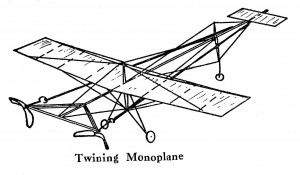
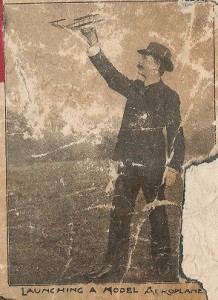
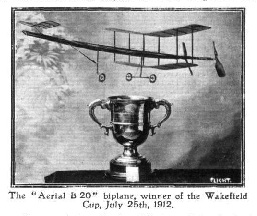
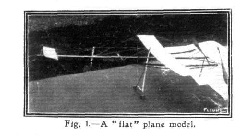
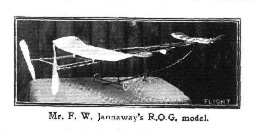
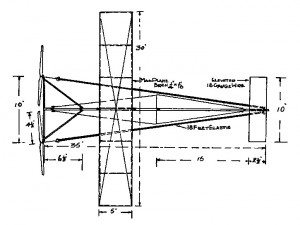
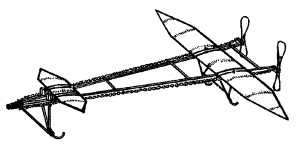
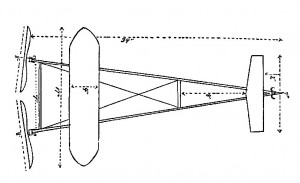
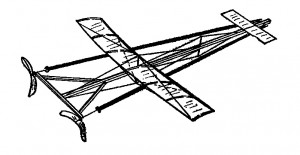
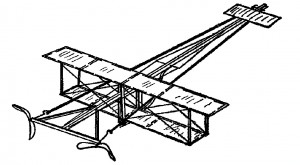
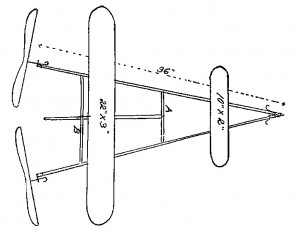
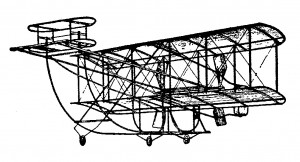
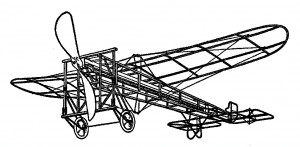
Interesting post. I have been trying to trace what happened to the K&MAA from the kite perspective. Of course it is very difficult but I have managed to locate a number of photographs taken pre-1914 … all showing kites, including the very large man/camera lifting train flown at Wimbledon Common. I have also acquired several bound volumes of French aviation periodicals pre-1914 including La Revue du Cerf Volant (Cerf Volant is the Stag Beetle, otherwise known as a kite) and can link these to the K&MAA. It is likely, therefore, that there is an archive somewhere for the model aircraft side and that, like my findings, is very likely to show that the group travelled at least into mainland Europe for competitions and cameraderie. Does anyone have this ‘other half’?
Enjoyed reading through this. My website, if I can call such a mess by that name, is an ongoing project! I have a very old model of Twining’s 1911 winning model and also the plans of Reginald Stedman’s (1912 winner) FULL SIZE aircraft!
Happy to send pictures if I have an email address.
Regards,
Tim
Fine web site and wonderful idea.
Our club IMAC was founded here in Chicago in 1911 and has been continually active since. Our oldest member Don lockwood , who joined in 1921 just passed at almost 100.
I am trying to find out more about G. P. Bragg Smith as he is my grandfather on my fathers side and I know very little about him. All help would be apprecited.
Clive,
I suggest you do a search in the Flight archive.
Also contact the Society of Antique Modelers. Some of them are knowledgible about the early history of model aviation, and they have a library.
Try the usual methods of geneological research from private and public records. You may find help at the library.
Gary
Dear Clive,
I have a small amount of information relating to Bragg Smith.
I’m told that he constructed his famous canard model for the son of the then Prime Minister – Asquith!
I’m also told that he gave up model making completely (and permanently?) at some point in time.
Please get in touch if you’re interested.
Tim
I must note that Kaynes seems to have been given credit for writing The International Wakefield Cup A History 1911 to 2011. Keynes only published my book, with my permission, for the benefit of FAI members. I hold a US Copyright authorship no. TX717-589 for The International Wakefield Cup A History 1911 to 1995. Please correct your files to reflect the proper authorship. CDR
Charles,
I did credit you as author of the Wakefield History. The FAI site went down temporarily and I changed the link to Kaynes’ alternate page. The FAI site is back up and I have changed the link back.
Gary
The 1911-14 International Wakefield Cup contests deserve attention,although I was more interested that the Wakefield Cup was started in 1911 after reading the SAM 35 Yearbook no.4, than checking for accuracy in their dimentions of Twinings 1911 Wakefield, or even his time. My living until 2011 to celebrate the International Wakefield Cup centenial quietly in my own mind, is all I can now manage. Good luck to all of you who love the International Wakefield Cup as I do! Carry on the great tradition! Good Luck!
I like the concept but I think the timeline may be too short. I know you put out this idea earlier but some of the available sketches/plans have only recently been presented. I’ll try to meet the July date.
As an old contributor of Vol Libre magazine in France, and new co-editor of VLT – Vol Libre Trimestriel – the future successor of Vol Libre… I will warn our readers and friends. We will make the regular report of this Centenary. Bonne chance! JW
Wonderful idea! Please add me to the email news letter/1 PLEASE!